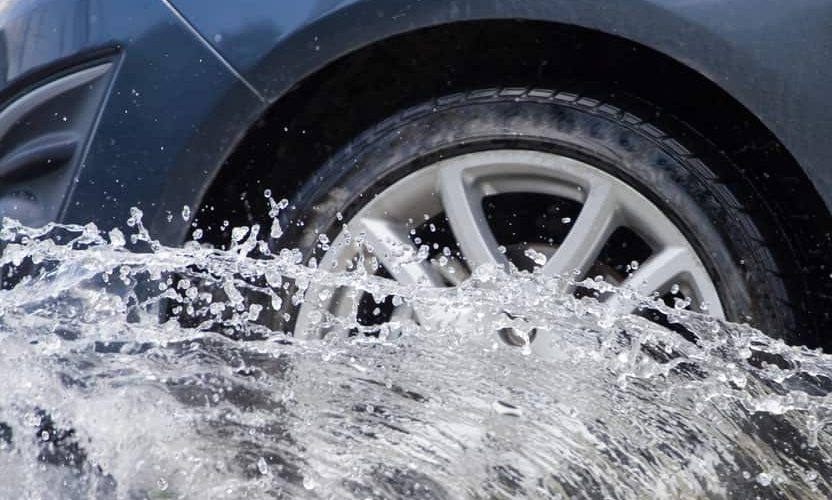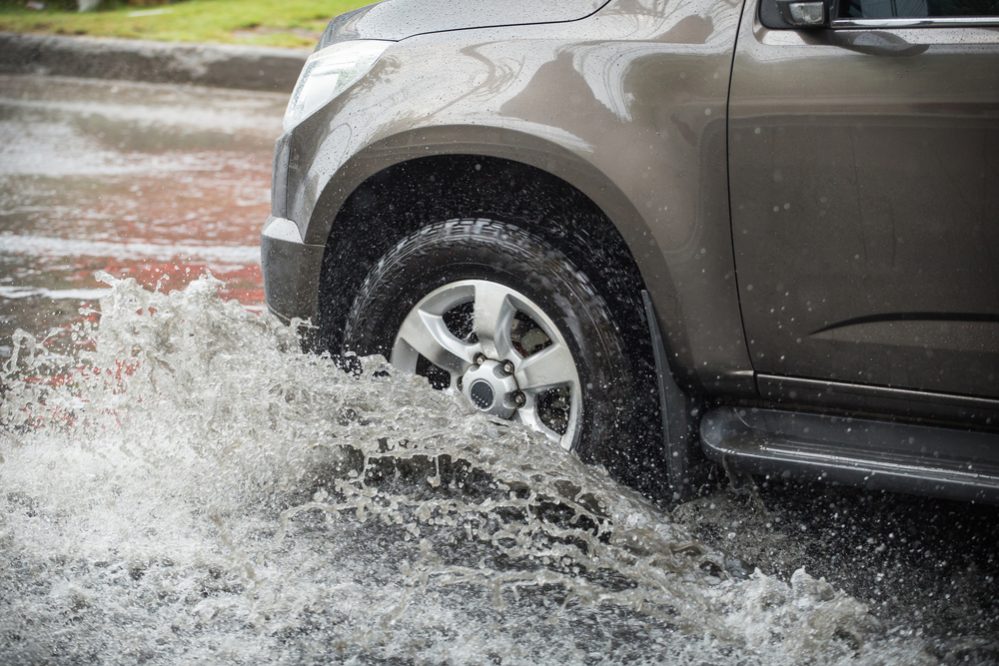Wet roads are the main culprit of vehicle-related accidents in the world. For example, in the U.S. alone, 73% of the weather-related accidents happen on wet pavement. And the main reason why this happens is hydroplaning.
But what is hydroplaning, and what causes it? Well, you’ll have to read on to find out, as the answer isn’t as simple and straightforward.
Moreover, I’ll give you several tips on how to avoid hydroplaning and save your vehicle from expensive damages when it rains.
What is Hydroplaning and What Causes It?
Hydroplaning happens when there is a sufficient amount of water on the surface, and the tires lose rolling traction.
It occurs because the tires start floating above the water, instead of cutting through it. Or, if you want it in layman’s terms, your car turns into a “boat.”
The issue intensifies when there is oil residue on the tarmac, something that happens very often nowadays. Oil stays on top of the water and makes things worse, making tires to hydroplane even in light rain.
When hydroplaning happens, the vehicle will start sliding, and the driver usually can’t do anything to prevent it. If it takes place at higher speeds, the driver can completely lose control of the car.
That’s especially true if the car is mid-corner and the front wheels are turned in one direction. However, hydroplaning can also spin a vehicle that drives in a straight line. Most often, that occurs if all wheels don’t encounter water at the same time.
The risk of hydroplaning grows exponentially as the velocity of the car increases. According to TireAmerica, there is a risk of hydroplaning at speeds over 45mph, with a water depth of only 1/10-inch.
Nevertheless, most modern tires have excellent hydroplaning resistance, and it takes a deep puddle of water to make them float.
The bad thing about hydroplaning is that your car won’t communicate the loss of road contact with you. Moreover, it happens in a fraction of a second. For that reason, many amateur drivers aren’t able to correct the slide with the steering wheel.
Tips to Avoid Hydroplaning
Fortunately, you can mitigate hydroplaning, and it all starts with taking care of your tires. Bad tires are the main reason why hydroplaning happens, so I’ll pay the most attention to them. Nonetheless, you can limit hydroplaning by following some driving tips, to which I will elaborate further down below.
1. Ensure That Your Tires Have Sufficient Tread Depth (If Not, Replace Them)
Different tires have various tread depths, but most of them can resist hydroplaning from the factory. However, as the tread of the tire wears down, the hydroplaning resistance diminishes.
Most tire manufacturers employ Tread Wear Indicators (TWI), so you can readily monitor the tread depth. The TWI’s are small rubber inserts built into the grooves of the tire, which are recessed when the tire is entirely new.
As the tread wears down, the indicators become more visible. When the tread wears down to 2/32-inch, the rubber bars will become flush with the tread pattern. This is the point when tire manufacturers believe that their products don’t offer reliable hydroplaning resistance.
If your tire doesn’t have TWI’s, you can check the tread depth with a Lincoln penny. Just turn the penny upside down and stick it into the tread. If Lincoln’s head is fully visible, it means that the tire has only 2/32-inch of tread depth left.
If your tires come to that point, you should immediately replace them. Otherwise, you risk losing rolling traction, even in light rain. Naturally, I recommend replacing the tires even sooner to better prepare for heavy rain situations.
2. Rotate Your Tires on Each Oil Maintenance
Most often, the tread of the tires wears down at a different rate from one side to another. This usually happens due to bad suspension components, but also on healthy vehicles.
To combat uneven wear, I recommend rotating the tires on each oil maintenance, or each 4,000 to 6,000-miles. That way, you’ll ensure that the tread depth on the tires is equal on both sides.
If you don’t rotate them, one side of the tires might be worn-down to 2/32-inch sooner and reduce hydroplaning resistance.
3. Keep the Tires Properly Inflated
Underinflated tires can significantly increase the chance of hydroplaning. And, this doesn’t only happen if you have a puncture. Tires lose pressure over time – there is no escaping it. Also, they can lose pressure if the outside temperature falls.
For those reasons, I recommend checking the tire pressure at least once a month. If the tires are underinflated, inflate them to the value provided by the vehicle manufacturer. You can find the values imprinted on the door sills, or in the user’s manual.
Just be sure that you don’t overinflate the tires, either. Overinflated tires also lose their hydroplaning resistance ability.
4. Drive Slowly in Heavy Rain
Hydroplaning increases considerably with each one mph of speed added because the tires will need to displace even more water. Therefore, as soon as it starts raining, you should reduce the velocity of your car.
By doing that, you will ensure that the tires keep their rolling traction. Otherwise, the tires won’t be able to channel all the water out of the tread pattern, and hydroplaning will occur.
5. Avoid Big Puddles of Water
Modern tires have the ability to resist hydroplaning on slightly wet surfaces. Nevertheless, big puddles of water can still be an issue.
Therefore, you should try to avoid standing water on the road as much as you can. Just be sure that you spot them on time. If not, it’s best not to make quick maneuvers with your car, or you’ll risk spinning out.
6. Avoid Longitudinal Depressions Once It Starts Raining
Longitudinal depressions are frequent sites on roads, and they arise specifically where larger vehicles drive. The problem with these depressions is that even light rain can fill them with water. Driving outside of these depressions is much safer, especially since they are easily avoidable.
7. Follow the Tracks of Other Vehicles
Following other vehicles might be e good tactic when it rains. The tires of the car in front will already displace much of the water, leaving your tires a much more manageable amount.
Just be sure that you don’t follow the car in front too closely. Otherwise, you risk losing visibility, which can prove to be an even bigger issue than having the tires hydroplane.
8. Avoid Using Cruise Control
Cruise control is a beautiful thing to have on longer trips. Nevertheless, leaving it on can harm hydroplaning resistance.
First of all, drivers are usually less alert when the cruise control is on. Moreover, they don’t keep attention to speed.
Also, the cruise control system can get confused once a wheel starts to hydroplane. Some systems might apply the brakes, or use more power once that happens, which will cause the car to spin.
How to Manage a Car That Starts Hydroplaning?
Once your vehicle starts to float over water on the road, it means that it begins to hydroplane. Fortunately, you can use some driving techniques to keep your car straight once it starts hydroplaning.
The most important thing, though, is not to panic. When drivers panic, they usually make the wrong decision, especially in these situations. Here is what you need to do:
Don’t Use the Brakes After the Vehicle Loses Rolling Traction
Never use the brakes once the wheels start to hydroplane. I know it feels like the right thing to do, but it will make things even worse. Hitting the brake pedal might cause the vehicle to spin immediately, precisely because the tires don’t have reliable contact with the road.
Instead, the best tactic is to lift off the gas pedal. That way, the velocity of your car will decrease without losing control. By doing that, you will limit the chances of spinning the car, which might prove to be very problematic if you drive in traffic.
Don’t Turn the Steering Wheel Abruptly
Just like with the brakes, you should never apply too much steering input in heavy rain. Abruptly turning the steering wheel might cause the vehicle to spin out of control.
Again, even if it feels natural to turn the wheel instantly, you are better off using slight adjustments. In other words, never turn the wheel too fast or too much.
Look for Open Space and Gently Steer in That Direction
Once you encounter a significant body of water, it’s best to steer out of it gently. Look for open space without standing water and steer your vehicle in that direction. Apart from turning the wheel, gently lift off the gas – it will help the tires regain contact with the road.
Conclusion
You can never be 100% safe when driving on wet roads, but, hey, that’s the nature of driving. Fortunately, you can get close to that number by following the rules above.
The thing is, learning how to drive takes time. That’s especially true if you don’t know all the lessons. If you want to learn faster, though, apply the tips I pointed out on each drive. And keep attention on the road, always.
If you have other questions related to hydroplaning, feel free to comment on this post. Also, if you found this article helpful, share it with the world – it will make roads safer for everyone!


